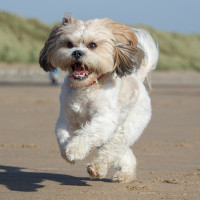Appearance of the Cock-A-Tzu
|
| The Cock-A-Tzu is a small but robust dog that is slightly longer than it is tall, with a short, deep, square muzzle and a broad, slightly domed skull. They generally have the dark, round eyes of the Shih Tzu, although the shape of the eyes can lean towards almond, and their ears are lobular or petal-shaped and usually set fairly high on the head and hang down, although the length of the ears can vary. They can carry their tail directly off the body, like the Cocker Spaniel, or it can be carried over the back like the Shih Tzu. Both parent breeds have a double-layered coat made up of a dense undercoat covered by stiff hair with a slight wave, although the Shih Tzu's coat is considerably longer than that of the Cocker Spaniel. Although this cross may resemble either of the parent breeds more closely, the majority of Cock-A-Tzus have a silky, medium-length coat that can range from wavy to curly, and comes in many color variations, often with white markings. |
Temperament of the Cock-A-Tzu
|
| The word most often used to describe the temperament of this particular crossbreed is cheeky. They tend to be on the good side and, as such, get along with almost everyone. They are highly intelligent and are generally fairly easy to train with positive training techniques, but can be emotionally sensitive to harsh reprimands. They're also fairly calm dogs and in most cases will only bark to alert you to something. Although they get on quite well with children, interactions with toddlers need to be supervised to protect both child and dog. Most of these dogs also get on quite well with strangers, although some can be a little more reserved, and they're generally friendly and gentle with other animals too. They don't do well when left alone for long periods and may be somewhat predisposed to developing separation anxiety. |
Needs and activities of the Cock-A-Tzu
|
| The Cock-A-Tzu cross has undemanding activity requirements and is generally content with twenty to forty minutes of vigorous activity a day, although dividing exercise sessions into several smaller periods of time is usually more effective. These little dogs are very happy living in smaller spaces with a few short walks or energetic play sessions indoors each day, and many can excel in hound activities, agility training designed for small dogs and advanced obedience training. They are quite intelligent, and some kind of mental stimulation will be needed to avoid overly vocal or destructive behaviors caused by boredom. These dogs are naturally quite calm and tend to make pleasant, polite housemates, making them a suitable choice for apartment living. |
Maintenance of the Cock-A-Tzu
|
| The Cock-A-Tzu should be bathed every six to eight weeks to help keep the coat shiny and clean, and in some cases they will need a trim at this time to even out any feathers that appear neglected. Brushing and combing, on the other hand, should be carried out daily. Although their soft, curly or wavy coats don't tend to shed much, they are very prone to tangling and knotting, which can become painful for your pet if not treated regularly. In some cases, this type of injury can lead to infection. They may also be more susceptible than average to developing cavities and other dental diseases, and regular brushing of a dog's teeth can prevent new cavities from forming. |









 English (United Kingdom)
English (United Kingdom)